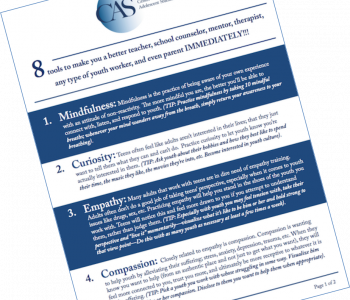

Sam Himelstein, PhD
Sam Himelstein is the founder and CEO of the Center for Adolescent Studies, Inc. He is passionate about working with youth and training the professionals that serve them.
4 Different Approaches to Leading Groups of Youth
Very early in my career, I began co-facilitating Mindfulness-Based Substance Abuse groups, with no training in how to lead groups of youth. My partner and I went from one extreme to the other, lecturing the first cohort and then having free-flowing discussions with the next cohort. We gradually realized that the groups were much more successful after we used an integrated approach, calling upon a diverse set of skills.
There are basically four different roles to choose from when teaching a class or leading a group: the supporter, the presenter, the facilitator, and the confronter. These skills are important for any group, but they are critical to understand when facilitating mindfulness with trauma-impacted youth.
Role #1: Presenter
In any group setting, there are times when we present information that participants may not have learned before. For example, in mindfulness groups with trauma-impacted youth, this material may include the meaning of mindfulness, the nature of trauma, the window of tolerance, how to identify triggers, etc. I often start with a presentation, using slides or handouts, to go over basic information.
Role #2: Facilitator
The primary skill of the facilitator is to “draw out” youth. To facilitate a discussion, for example, means to prime the group so they can engage in the topic via their own interest and motivation. Facilitating is like starting a fire, while each action of engagement from a youth in the group is like putting extra wood into the fire to keep it going.
This skill of “drawing out” manifests itself when we prime youth to answer discussion questions, practice self-disclosure, think critically, and engage in activities that ultimately build more group cohesiveness. Such activities range from simply asking questions, to trust-building activities, to resolving conflicts.
Role #3: Confronter
Confronting youth doesn’t mean arguing with them or pushing them around. What I mean by confrontation is the practice of explicitly “calling in” students or clients, often when resistance arises, when tension is apparent, or when some boundary has been overstepped. Calling in brings youths’ attention to a situation or boundary to help them develop self-awareness, as opposed to “calling them out” in a punitive manner.
Confronting, or directly intervening, could include anything from simple clarifications to extremely uncomfortable boundary setting. This is a very important, and sometimes very challenging, role when working with trauma-impacted youth.
Consider the following examples:
- You’re leading a mindful check-in with a group of young people. The first couple of kids take a deep breath and check in using present moment language, as instructed. The third youth, however, uses just a non-descriptive word such as “cool” or “fine.” You may want to briefly interrupt in order to clarify the instruction of how to do a mindful check-in.
- One youth feels disrespected by another youth. Simple disruption escalates into disrespect and conversation turns into argument. There is a serious risk for physical violence if you do not intervene in the moment. You need to decide very quickly how to intervene in a way that will deescalate the situation.
Role #4: Supporter
You may have had the experience of thoughtfully developing a group agenda or lesson plan only to be blindsided when the group starts with tragic news that alters the course of the session. A youth’s parent may have been incarcerated, a family member may have passed away, or a friend may have overdosed. Real-life events can impact our groups, and the curriculum will need to be set aside in these instances.
Let’s imagine, for example, that as the youth in the group are checking in, one of them bursts into tears and discloses that his cousin has been shot and killed. Would you still simply have him check in, and then move on to the next group member, get through the check-in, and then move on to whatever was next on your curriculum agenda? Of course not. To do so would significantly damage the relationship and violate a core tenet of trauma-informed practices.
Instead, we respond in whatever way we feel is essential to maintaining the relationship and supporting the young person. We cast “techniques” aside and sit with the suffering and humanity of another person going through tragic loss.
Some youth may not want to be focused on, due to their defenses and protective mechanisms, but that is for us to discern after leaning in with the initial offering of support. The Supporter is important role to activate when appropriate, as it contributes immensely to fostering interpersonal safety and strengthening the relationship. When a youth feels supported and cared for, receptivity to your curriculum content and to you as a person rises. This contributes to better outcomes for your class or group.
Conclusion: Don’t Over-Identify with One Role
A good rule of thumb for successful class management or group leadership is that you don’t spend too much time in any one facilitator role. It’s important to reflect regularly on how much time you spend in each role. If you present a lot, you run the risk of the youth feeling “talked at” and disengaged. If you are in the supporter or facilitator roles too much, they may not be engaging with enough of the course content. And if you’re in the confronter role too much, you run the risk of participants feeling judged, overanalyzed, and ultimately unsafe. Balancing your didactic (i.e., psycho-education), process and discussion-based, and experiential activities will naturally vary your roles as a teacher or group leader, which will keep youth engaged and contribute to a positive learning experience.
If you found this information useful, you may also be interested in the following posts by Dr. Sam Himelstein, the director of the Center for Adolescent Studies, on effectively working with groups of youth:
- 2 Simple Tips to Create a Welcoming, Trauma-Informed Classroom
- 4 Simple Tips for Creating Safety with Group Agreements
- Mindful Classroom Management: A Tried and True Technique for Getting Youth Back on Track
- Teaching Meditation to Teens Who Have the Giggles
You might also benefit from Heart Spring, an online community for helping professionals to continually evolve self-care and resilience practices, learn skills to bring to those they work with, and connect to a larger helping community.

